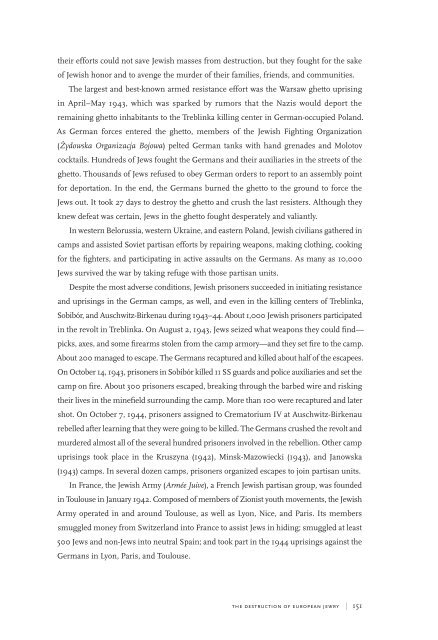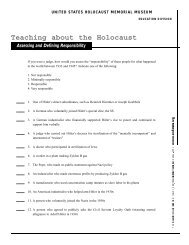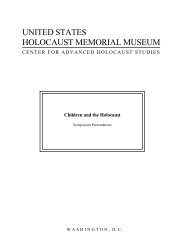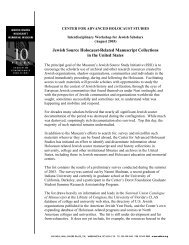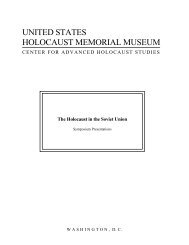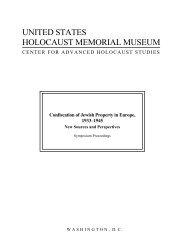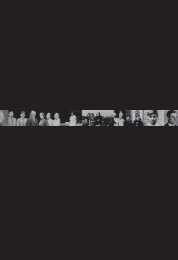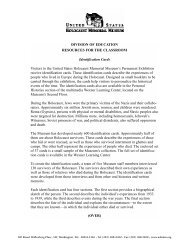the quest for racial purity - United States Holocaust Memorial Museum
the quest for racial purity - United States Holocaust Memorial Museum
the quest for racial purity - United States Holocaust Memorial Museum
Create successful ePaper yourself
Turn your PDF publications into a flip-book with our unique Google optimized e-Paper software.
<strong>the</strong>ir ef<strong>for</strong>ts could not save Jewish masses from destruction, but <strong>the</strong>y fought <strong>for</strong> <strong>the</strong> sake<br />
of Jewish honor and to avenge <strong>the</strong> murder of <strong>the</strong>ir families, friends, and communities.<br />
The largest and best-known armed resistance ef<strong>for</strong>t was <strong>the</strong> Warsaw ghetto uprising<br />
in April–May 1943, which was sparked by rumors that <strong>the</strong> Nazis would deport <strong>the</strong><br />
remaining ghetto inhabitants to <strong>the</strong> Treblinka killing center in German-occupied Poland.<br />
As German <strong>for</strong>ces entered <strong>the</strong> ghetto, members of <strong>the</strong> Jewish Fighting Organization<br />
(Z · ydowska Organizacja Bojowa) pelted German tanks with hand grenades and Molotov<br />
cocktails. Hundreds of Jews fought <strong>the</strong> Germans and <strong>the</strong>ir auxiliaries in <strong>the</strong> streets of <strong>the</strong><br />
ghetto. Thousands of Jews refused to obey German orders to report to an assembly point<br />
<strong>for</strong> deportation. In <strong>the</strong> end, <strong>the</strong> Germans burned <strong>the</strong> ghetto to <strong>the</strong> ground to <strong>for</strong>ce <strong>the</strong><br />
Jews out. It took 27 days to destroy <strong>the</strong> ghetto and crush <strong>the</strong> last resisters. Although <strong>the</strong>y<br />
knew defeat was certain, Jews in <strong>the</strong> ghetto fought desperately and valiantly.<br />
In western Belorussia, western Ukraine, and eastern Poland, Jewish civilians ga<strong>the</strong>red in<br />
camps and assisted Soviet partisan ef<strong>for</strong>ts by repairing weapons, making clothing, cooking<br />
<strong>for</strong> <strong>the</strong> fighters, and participating in active assaults on <strong>the</strong> Germans. As many as 10,000<br />
Jews survived <strong>the</strong> war by taking refuge with those partisan units.<br />
Despite <strong>the</strong> most adverse conditions, Jewish prisoners succeeded in initiating resistance<br />
and uprisings in <strong>the</strong> German camps, as well, and even in <strong>the</strong> killing centers of Treblinka,<br />
Sobibór, and Auschwitz-Birkenau during 1943–44. About 1,000 Jewish prisoners participated<br />
in <strong>the</strong> revolt in Treblinka. On August 2, 1943, Jews seized what weapons <strong>the</strong>y could find—<br />
picks, axes, and some firearms stolen from <strong>the</strong> camp armory—and <strong>the</strong>y set fire to <strong>the</strong> camp.<br />
About 200 managed to escape. The Germans recaptured and killed about half of <strong>the</strong> escapees.<br />
On October 14, 1943, prisoners in Sobibór killed 11 SS guards and police auxiliaries and set <strong>the</strong><br />
camp on fire. About 300 prisoners escaped, breaking through <strong>the</strong> barbed wire and risking<br />
<strong>the</strong>ir lives in <strong>the</strong> minefield surrounding <strong>the</strong> camp. More than 100 were recaptured and later<br />
shot. On October 7, 1944, prisoners assigned to Crematorium IV at Auschwitz-Birkenau<br />
rebelled after learning that <strong>the</strong>y were going to be killed. The Germans crushed <strong>the</strong> revolt and<br />
murdered almost all of <strong>the</strong> several hundred prisoners involved in <strong>the</strong> rebellion. O<strong>the</strong>r camp<br />
uprisings took place in <strong>the</strong> Kruszyna (1942), Minsk-Mazowiecki (1943), and Janowska<br />
(1943) camps. In several dozen camps, prisoners organized escapes to join partisan units.<br />
In France, <strong>the</strong> Jewish Army (Armée Juive), a French Jewish partisan group, was founded<br />
in Toulouse in January 1942. Composed of members of Zionist youth movements, <strong>the</strong> Jewish<br />
Army operated in and around Toulouse, as well as Lyon, Nice, and Paris. Its members<br />
smuggled money from Switzerland into France to assist Jews in hiding; smuggled at least<br />
500 Jews and non-Jews into neutral Spain; and took part in <strong>the</strong> 1944 uprisings against <strong>the</strong><br />
Germans in Lyon, Paris, and Toulouse.<br />
<strong>the</strong> destruction of european jewry | 151


